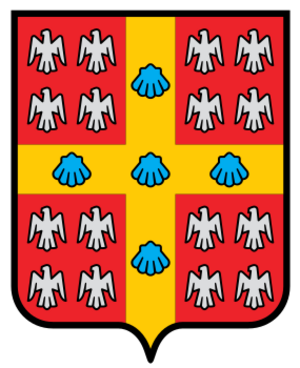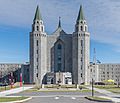Université Laval facts for kids
|
Laval University (English)
|
|
 |
|
| Latin: Universitas Laval | |
|
Former names
|
Séminaire de Québec (1663-1852) |
|---|---|
| Motto | Error {{native name}}: a name as parameter {{{2}}} is required (help) |
|
Motto in English
|
By the grace of God, to no one equal |
| Type | Public |
| Established | 1852 |
|
Academic affiliations
|
ACU, CARL, UArctic, Universities Canada, U15 |
| Endowment | CAD$377 million |
| Rector | Sophie D'Amours |
| Students | 47,690 |
| Undergraduates | 33,430 |
| Postgraduates | 14,260 |
| Location |
Quebec City, Quebec
,
Canada
46°46′48″N 71°16′29″W / 46.78000°N 71.27472°W |
| Campus | Urban/Suburban |
| Language | French |
| Colours | Red & gold |
| Nickname | Rouge-et-Or |
|
Sporting affiliations
|
CIS, QSSF |
The Université Laval is a big public research university in Quebec City, Canada. It started from the Séminaire de Québec, which was founded way back in 1663. This makes it the oldest place for higher education in Canada. It was also the first in North America to offer university-level studies in French. The university began in Old Québec but moved to a new campus in the 1950s. Today, it's known as one of the top 10 Canadian universities for research.
Contents
History of Université Laval
How it Started
Université Laval's story began in 1663. That's when the Grand Séminaire de Québec was founded. A few years later, in 1668, the Petit Séminaire was also started. Both were created by François de Montmorency-Laval. He was the first Bishop of New France.
For a long time, the school mainly trained priests. After 1760, when the British took over, education in Canada grew. It started to include subjects like arts and sciences. French Canadians didn't have many chances for higher education then. So, Bishop Bourget of Montreal suggested making the Séminaire de Québec into a university.
Becoming a University
Louis Casault, a priest who taught physics, traveled to Europe. He wanted to learn about the best universities there. He also looked for a special document called a royal charter. This charter would give the school the right to be a university.
On December 8, 1852, Queen Victoria gave the Séminaire de Québec a royal charter. This happened because Lord Elgin, who was the Governor-General, asked her to. The charter officially created the Université Laval. It gave the new university "the rights and privileges of a university." Later, Pope Benedict XV also approved the university. He allowed it to teach theology and give out degrees.
Growing and Changing
In 1878, Université Laval opened another campus in Montreal. This campus later became its own university, called the Université de Montréal, in 1919. In 1971, a new charter gave all power to the Université Laval council.
By 1925, the university had become too big for its original spot. The Old City was very crowded. So, in the 1950s, the university moved to Sainte-Foy. This was a more open area west of Quebec City. However, the School of Architecture moved back to the old building in 1989. People now call it Le Vieux Séminaire (The Old Seminary).
In the early 1900s, people wanted more than just religious or law studies. So, the university added new departments. These included science and social sciences, like forestry. They also started offering advanced studies where students did research projects.
In 1929, the Quebec Seminary was named a special historic site in Canada. The university also started a department for social, political, and economic sciences in 1938. This showed a new idea: that higher education could help people and society.
The royal charter that started Université Laval in 1852 was also named a National Historic Event in 1972. The original location still trains Roman Catholic priests. Part of the old seminary has been home to the university's architecture school since 1987.
University Buildings and Features
Campus Buildings
Today, the main campus is about 1.2 square kilometers (0.46 square miles). It has over 30 buildings, also called pavillons. Many of these buildings have a modern design. The first buildings and outdoor areas were designed by Edouard Fiset in the 1950s. About 56% of the campus land is covered by woods, grassy areas, and sports fields.
Other Campus Features
Almost all the buildings on campus are connected by 10 kilometers (6.2 miles) of underground walkways. These are very helpful in winter. The walls of these tunnels are often covered with colorful murals and graffiti by students.
The campus also has the Roger-Van den Hende botanical garden. This garden has about 67 types of trees and 60 different kinds of birds. The Louis-Jacques-Casault building holds a part of the National Archives of Quebec.
The main sports building is called PEPS. It is one of the biggest sports complexes in eastern Canada. Next to it is the covered TELUS stadium. Construction for the stadium began in 2010 and it opened in January 2012.
Off-Campus Locations
Besides the main campus, Université Laval has a few other locations. The school of architecture is in Old Quebec since 1988. The school of visual arts is in the downtown area of Saint-Roch. There is also the experimental Montmorency Forest, which is about 70 kilometers (43 miles) north of Quebec City.
University Programs
As of 2002, Université Laval offered more than 350 different study programs. Over 38,000 students attended the university. Each year, more than 2,500 students from other countries come to study here. Also, almost 1,000 students come from other Canadian provinces.
Many students join the Français pour non-francophones program. This program teaches French as a second language to students from all over the world. Université Laval is also the only university in Quebec that trains forestry engineers.
Since the mid-1980s, the university has offered distance learning. This means students can take classes from far away. Over 30 programs and 400 courses are available this way. About 80% of these can be accessed online.
Faculties and Schools
Université Laval is divided into many different faculties and schools. Each one focuses on a specific area of study.
- Administrative Sciences
- Agriculture and Food sciences*
- Architecture, Urban planning and Visual arts
- Dentistry
- Education
- Faculté de Droit (Faculty of Law)
- Faculté des Lettres et des Sciences humaines (Letters and Humanities)
- Forestry, Geography and Geomatics**
- Hautes Études Internationales (HEI)
- Arts
- Medicine
- Music
- Nursing
- Pharmacy
- Philosophy
- Postgraduate Studies
- Science and Engineering
- Social Sciences
- Theology and Religious Studies
* The Department of Food Science and Nutrition has a program that trains dietitians. Graduates can become registered dietitians.
University Research
Université Laval is home to four of Canada's 19 Canada Excellence Research Chairs. These are special research positions given to top scientists. The chairs at Laval focus on things like studying the Arctic from space, understanding how our bodies work, new light technologies, and brain science.
The university is also an active member of the University of the Arctic (UArctic). UArctic is a group of over 200 universities and organizations. They work together to promote education and research in the Arctic region. Université Laval takes part in UArctic’s north2north program. This program lets students from member schools study in different parts of the North.
University Press
Les Presses de l'Université Laval (University Press) was started in 1950. It publishes books about Canadian history, literature, medieval studies, law, social sciences, and engineering. They publish about 120 books each year.
University Cooperative
The Coopérative de l'Université Laval (University Co-op) sells products to students and staff. These include books, notes for classes, and computers. They have two locations: one on campus and another near the Arts building in Old Québec.
Athletics and Sports Teams
Sports at Laval take place at the Pavillon d'éducation physique et des sports (Physical Education and Sports Complex), or PEPS. Laval's sports teams are called the Rouge-et-Or (Red & Gold). As of 2024, the men's football team has won the Vanier Cup 12 times. This is the most titles in the country!
Notable People from Université Laval
Many famous people have studied at Université Laval. These include Prime Ministers of Canada, Premiers of Quebec, Supreme Court Justices, and important athletes. Some well-known alumni are:
- Prime Ministers of Canada: Louis St. Laurent, Brian Mulroney and Jean Chrétien
- Premiers of Quebec: Lucien Bouchard, Pierre-Joseph-Olivier Chauveau, Edmund James Flynn, Jean Lesage, René Lévesque, Pauline Marois, Simon-Napoléon Parent and Louis-Alexandre Taschereau
- Supreme Court Justices: Suzanne Côté, Louis LeBel, Claire L'Heureux-Dubé, Charles Fitzpatrick, Arthur Cyrille Albert Malouin, Lawrence Arthur Dumoulin Cannon, Louis-Philippe Pigeon, Julien Chouinard, Robert Taschereau, Henri-Elzéar Taschereau, Thibaudeau Rinfret
Images for kids
-
L'Homme devant la Science (1963), a mural by Jordi Bonet on Adrien-Pouliot Hall.
-
An underground pedestrian tunnel connecting buildings.
-
Louis St. Laurent, the 12th Prime Minister of Canada.
-
Brian Mulroney, the 18th Prime Minister of Canada.
-
Jean Chrétien, the 20th Prime Minister of Canada.
-
Niklaus Wirth, who designed several computer programming languages.
-
Charles Fitzpatrick, the fifth Chief Justice of Canada.
See also
 In Spanish: Universidad Laval para niños
In Spanish: Universidad Laval para niños
- List of universities in Quebec
- List of universities in Canada
- Group of Thirteen (Canadian universities)
- Laval Thomism
- Jérôme Demers
- List of oldest universities by region
- Quebec City
- Canadian university scientific research organizations
- Higher education in Quebec
- CHYZ campus radio station
- Medicago Inc.




























